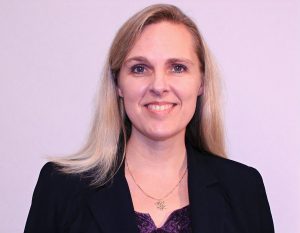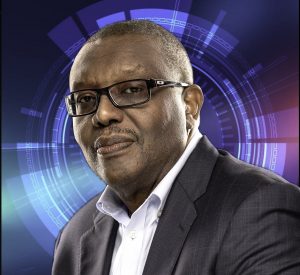 POLICY
POLICY
 POLICY
POLICY
 POLICY
POLICY
Nicole Radziwill graduated from Pennsylvania State University at the age of 18 and went on to earn an MBA and a Ph.D. in technology management and quality systems. She taught data science at the university level for 11 years, did a stint as editor-in-chief of the academic journal Software Quality Professional and has been a national examiner for the Malcolm Baldrige National Quality Award for more than a decade. She has written three books on statistics, one of which is a standard textbook in more than 25 universities.
By all accounts, Radziwill is brilliant and successful in her field, but a two-hour business meeting can inflict sensory overload. Stress factors in the workplace include lights, smells, loud conversations and even the sensation of wearing business attire. “Nothing is comfortable ever,” she said.
Radziwill is on the autism spectrum, a broad range of conditions that affect people’s social and attentional abilities. Like some autistic people, she struggles with vaguely defined tasks and agendaless meetings. But also like some autistic people, she has an exceptional ability to absorb information, spot patterns and visualize structure, skills that are particularly well-suited to her work in data science.
Her hyperlexia, a condition common to autistic people that bestows exceptional reading ability at an early age but often without corresponding language and speech skills, makes her a human sponge of information. Rajesh Anandan, co-founder of the New York-based quality engineering firm Ultranauts Inc., where Radziwill is a senior vice president, remembers preparing for one client engagement that involved reading through hundreds of pages of highly technical documentation and code. “It would have taken us weeks to ingest it and zero in on the issues,” he said. “Nicole processed it in a weekend.”

Nicole Radziwill challenges the stereotype that autistic people can’t succeed in leadership roles. Photo: Nicole Radziwill
Radziwill epitomizes the mystery of autism, a neural physical condition that manifests itself in many ways and is little understood. Autistic people – who are also called “neurodiverse” — have been stereotyped for years as incapable of functioning in the workplace. Although there’s no one characteristic common to everyone on the autism spectrum, many autistic people experience discomfort in social situations, are inwardly focused and find face-to-face communication exhausting.
“It’s very easy for co-workers to misread me and it’s not uncommon for that to cause minor misunderstandings,” said Dyllan Rafail, a test specialist at IBM Corp. who joined the company three years ago as part of IBM’s newly hatched “Autism as a Skill” program.
Autistic people can be productive, independent and even highly successful: The list of notable people who were diagnosed or suspected to be autistic includes Charles Darwin, Bobby Fischer, Steve Jobs and Thomas Jefferson. However, some have difficulty making it through the day in a typical workplace without significant support.
The difficulties many autistic people experience interacting in the workplace often frightens away prospective employers. By some estimates 85% of college graduates on the autism spectrum are unemployed or underemployed.
But attitudes are changing, particularly in high-tech fields where a chronic shortage of talent is prompting employers look for creative solutions. It turns out that the often extraordinary ability of neurodiverse people to focus and filter out external stimuli can be an asset for jobs that require intense concentration, such as programming. What’s more, some autistic people show a prodigious ability to solve problems, improve processes and create program logic.
That was the case with Radziwill, whose statistical skills enable her to “fast-forward through a terabyte of information and find the nuggets. I was fortunate to be obsessed at an early age with something that helped people make money,” she said. At Ultranauts, a firm that employs mostly autistic people, she fulfills a senior leadership role, challenging the stereotype that autistic people can’t lead.
“Nicole is architecting large parts of our business,” Anandan said. “She’s an exceptional leader and manager, not just a doer.”

IBM’s Rafail: “Exploring unique solutions to complex problems turns my hours into perceived minutes.” Photo: IBM
Rafail joined IBM three years ago as part of its newly hatched “Autism as a Skill” program and within 10 months had redesigned its process for testing point-of-sale devices. He’s gone on to earn more than a half-dozen IBM and industry innovation awards. “Exploring new possibilities or unique solutions to complex problems turn my hours into perceived minutes,” he said.
Some of the success stories are striking. Two years ago, Computer Aid Inc. or CAI, an Allentown, Pennsylvania-based technology services firm, placed a cohort of its autistic employees with client HM Health Solutions Inc. “We started small with six, just to see how it worked out and they quickly completed the output of the other 30 contractors,” Eddie Batcho, team manager of IAM security operations at HM Health, said in a video interview. “Their rework rate was less 1% where we were at about 8% before that.”
One autistic IBM employee has been listed as a co-inventor of four patents. The winner of SAP SE’s highest employee recognition in 2019 was a 21-year-old accounts payable analyst who invented an automated process that cut the time needed to create complex cross-company invoices from more than two days to 20 minutes. Nicolas Neumann, who was the first individual ever to win the award, had joined the company through its Autism at Work program.
“It’s not uncommon to see neurodivergent individuals outperform their neurotypical peers by 20% to 60%,” said Wayne McRae, director of CAI’s Autism2Work program.
But the paradox of autism – that people with sometimes painfully poor social skills can also have extraordinary intellectual powers – has also become a bit of a stereotype, fueled in part by pop culture icons like the 2001 biographical film “A Beautiful Mind” about the prodigious mathematician John Nash, a schizophrenic who may also have had Asperger’s Syndrome. In fact, experts say, the neurodiverse population performs at about the same level as everybody else.
“Don’t play into tropes around superpowers,” Anandan said. “I have teammates who are off the charts on many dimensions but that doesn’t mean all autistic people are.”
Another stereotype is that autistic people are only suited for technical jobs. “All jobs are good for autistic talent: lawyers, congressmen, artists,” Anandan said. “Do autistic adults over-index on being able to do deep work that requires intense focus? Our experience is yes, but that’s not to say they can’t do jobs that aren’t driven by deep work.”
Nevertheless, it’s tech companies that are clearly leading the way in tapping into an often talented but underused resource. In addition to IBM and SAP, Microsoft Corp. and Dell Technologies Inc. also have neurodiversity initiatives.
SAP’s pioneering program has brought about 600 people into the company in various employment and contractor capacities in the six years since it was created, said Jose Velasco, an SAP business process intelligence program director and ambassador for Autism at Work. Graduates fill 29 different types of roles of the company.
“Whether you bake bread or arrange flowers, open your doors to someone on the spectrum and you’ll have a wonderful and productive employee,” he said.

SAP’s Velasco: “Open your doors to someone on the spectrum and you’ll have a wonderful and productive employee.”
IBM’s initiative now encompasses more than 500 people in eight countries. Nearly 2,000 employees have also completed a training program on how to work with autistic peers. “All open roles are available for neurodivergent talent,” said Diane Delaney, IBM’s program manager for neurodiversity. She noted, nevertheless, that many roles to which employees gravitate are technical, including developers, software engineers, data scientists and cybersecurity analysts.
If people on the autism spectrum are just as capable as anyone else, why is the unemployment rate so high? Experts say the process organizations typically use to vet potential employees deserves a lot of the blame. Traditional hiring tactics center on interviews, often handing off candidates to multiple managers in a single marathon session. Given that many autistic people struggle with social interactions, the process can doom them to failure from the start.
Amber Flanagan thought her bachelor’s degree in psychology from Penn State University had prepared her well for the job market, but scores of applications yielded just a handful of interviews. “It was discouraging because I felt like what’s the point if nobody is going to give me a chance?” she said. “It’s unfair to penalize someone who went through all the time and work to get a degree.”
While working as a grocery store cashier she got a lead from a Pennsylvania state agency that CAI might be a good fit. “CAI allowed me to skip the standard interview process” in favor of a less pressured three-step interview and job readiness training, she said. “They saw that I could clearly work in a neurotypical environment and do well.”

CAI’s McRae: “It’s not uncommon to see neurodivergent individuals outperform their neurotypical peers by 20% to 60%.” Photo: CAI
Flanagan has Asperger’s syndrome but is considered high-functioning and had no reservations about jumping on a Microsoft Teams video call for a face-to-face interview. She has flourished as a quality analyst working on-site at HM Health because “I’m focused on details, but I don’t overfocus and get swamped,” she said. “It allows me to get a lot of things done efficiently.”
Most neurodiversity advocates agree that the traditional hiring gauntlet focused on prior experience and interviews is hopelessly out-of-date for a diverse workforce. “There have been endless studies on how ineffective both of those tools are,” said Ultranauts’ Anandan.
His company instead uses job tests and work simulations tuned to the needed skills. “It’s not hard to construct tests that help identify those skills,” he said. Interviews are part of the process, but a disciplined scoring rubric is applied “to minimize the potential for human bias to color the output,” Anandan said. Ultranauts also takes pains to make explicit the unwritten workplace rules that neurotypical people take for granted but that autistic people often have difficulty picking up.
Spelling out the rules for success pays off for all employees, he said. “Define what’s expected of everyone day to day and what they need to move up instead of requiring them to navigate and figure it out,” Anandan said. “It’s better for everyone.”
CAI starts with a low-pressure telephone screening and invites promising candidates, as well as any support people they choose, to a meet-and-greet session. “It’s about removing the anxiety; we’re assessing their success at following steps in a process and also to be sure this is something they really want to do,” McRae said. An eight-day job readiness training program precedes formal employment.
SAP’s onboarding program is even more intensive, spanning six weeks and culminating in an exercise that coaches prospects through the process of running a simulated company and presenting to a group of stakeholders. “We want to get to the know the person behind the label and sometimes it takes a little longer to do that,” Velasco said.
In the process candidates build a portfolio, resume, LinkedIn profile and a bridge into the interview process that benefits them in the long term. Velasco pointed with pride to the fact that 25% of the people who complete the training choose to work for other employers. “We talk more in terms of opportunities more than jobs,” he said.
Any organization that hopes to embrace neurodiversity will face internal resistance. Advocates say the best strategy is to talk up the benefits of bringing different points of view to bear on problems. “Think of neurodiversity as a difference rather than a disability,” Velasco said, citing legendary computer scientist Alan Kay’s assertion that “a change of perspective is worth 80 IQ points.”
Don’t pitch the effort as altruistic or an exercise in corporate social responsibility, either. People who are regarded as charity cases never get the opportunities they deserve, advocates say. “No chief data officer is going to hand over the work that allows their data scientists to build good models because they want to do good,” Anandan said.
The fact that autistic people often need to have processes explained to them can provoke introspection that any organization can use. “Ultranauts are unafraid of asking ‘Why?’, even when it gets uncomfortable,” Radziwill said. “That ultimately leads to better solutions.”
THANK YOU